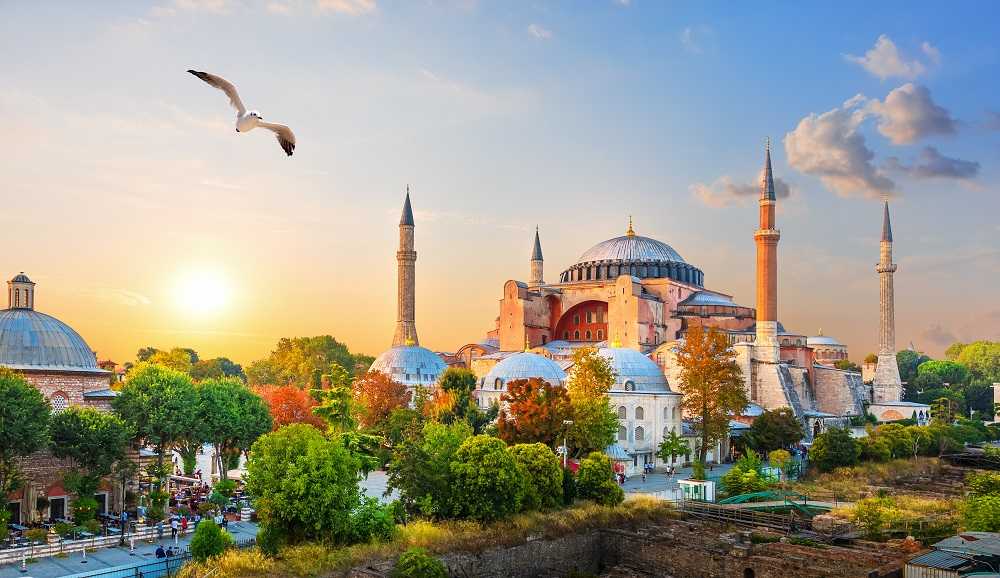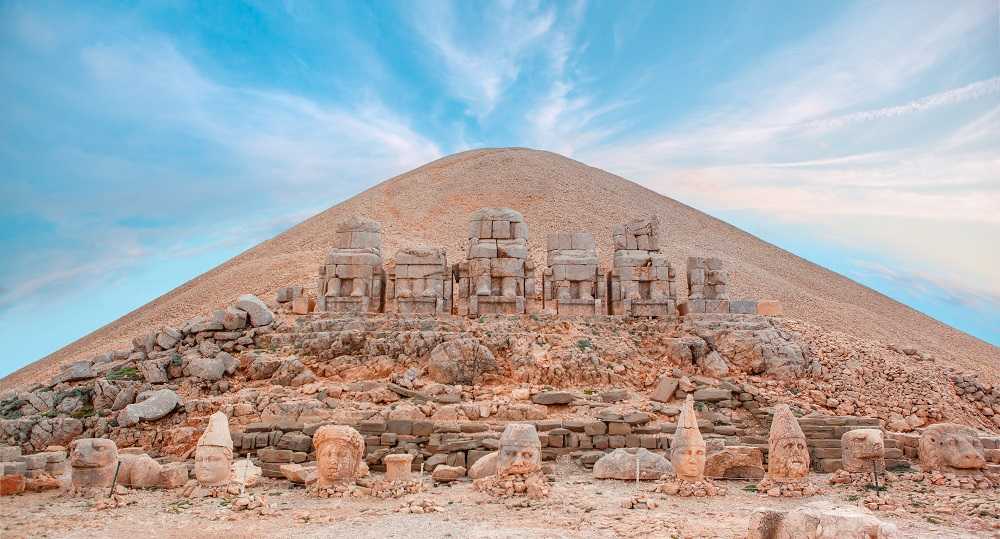9 of the most interesting and beautiful sights in Turkey.
Turkey is one of the favorite countries of Romanian tourists. Most of them choose to travel in one of the the beautiful resorts of Antalya, Turkey. But more and more tourists from Romania choose to discover Istanbul, to experience a balloon flight in Cappadocia and to be attracted by the tourist-historical objectives in Turkey.
In this article we will tell you about 9 of the most interesting and beautiful sights in Turkey. There are definitely more and we invite you to share your favorite comments in a comment. We invite you to read.
Hagia Sofia
Istanbul is a unique city, located on 2 continents, which offers satisfaction to even the most curious tourist. Istanbul, historically known as Byzantium and Constantinople, is the largest city in Turkey and the economic, cultural and historical center of the country. The city is located on the Bosphorus Strait and is located in both Europe and Asia, with a population of over 15 million inhabitants, representing 19% of the population of Turkey. Istanbul is the most populous city in Europe and the fifteenth largest city in the world.

It's in Istanbul Hagia Sofia, one of the most impressive buildings in the world, the church transformed into a mosque, where the mixture of Byzantine and Oriental elements is truly enchanting. Hagia Sophia, officially the Holy Great Mosque of Hagia Sophia and formerly the Church of Hagia Sophia, is a place of worship, designed by Greek geometers Isidore of Miletus and Anthemius of Tralles.
Built in 537 to be the patriarchal cathedral of the imperial capital of Constantinople, it was the largest Christian church in the Eastern Roman Empire (Byzantine Empire) and the Eastern Orthodox Church, except for the Latin Empire from 1204 to 1261, when it became the cathedral. Roman Catholic city. In 1453, after the fall of Constantinople, it was transformed into a mosque. In 1935, the secular Turkish Republic turned it into a museum. In 2020, it was reopened as a mosque.
Sultan Ahmed Mosque (Blue Mosque)
Near Hagia Sophia is the National Mosque of Turkey, the largest in Istanbul, known as Blue Mosque. The Sultan Ahmed Mosque (Turkish: Sultan Ahmet Camii), also known as the Blue Mosque, is a Friday mosque built in the Ottoman era. It is a functional mosque that attracts a large number of tourists.
It was built between 1609 and 1616, during the reign of Ahmed I. Its Külliye contains Ahmed's tomb, a madrasah and a hospice. The hand-painted blue tiles adorn the interior walls of the mosque, and at night the mosque is bathed in blue, while the lights frame the mosque's five main domes, six minarets and eight secondary domes. It is located next to Hagia Sophia, which was the main mosque in Istanbul until the construction of the Blue Mosque.
Cappadocia

Cappadocia it is a famous place due to the unique landscape offered by the underground cities, the cave churches and the houses dug into the rock. The city is also on my bucketlist with tourist attractions in the world that I want you to visit. Cappadocia is a historical region of Central Anatolia, mostly in the provinces of Nevsehir, Kayseri, Kırșehir, Aksaray, Malatya, Sivas and Niğde in Turkey. From the end of the 300s BC, the name of Cappadocia came to be limited to the interior province, sometimes called the Sea Cappadocia.
The name, traditionally used in Christian sources throughout history, continues to be used as a concept of international tourism to define a region of exceptional natural wonders, characterized especially by fairy baskets and a unique historical and cultural heritage.
Neighborhood Cappadocia it is also recognized among tourists for its famous hot air balloon rides. In high season, hundreds of balloons are lifted from the ground in the light of sunrise.
Pamukkale
Pamukkale or "Cotton Castle", is a huge limestone rock in which the thermal waters have formed natural pools, waterfalls and even stalactites. They are all so white that they look like ice, hence its name. It was added as a UNESCO World Heritage Site in 1988 along with Hierapolis.
People have visited the area for thousands of years, due to the attraction of the thermal pools. In the middle of the XNUMXth century, hotels were built over the ruins of Hierapolis, causing considerable damage. When the area was declared a UNESCO World Heritage Site, the hotels were demolished and the road was removed and replaced with artificial pools. There are well-preserved Roman ruins and a museum. However, travertine terraces are all prohibited, suffering damage, erosion and pollution due to tourism.
Topkapi Palace
Topkapi Palace is a complex of gardens and buildings, which have been the main residence of the Ottoman sultans for almost 400 years. Topkapı Palace, or Seraglio, is located in the Fatih district of Istanbul.

After the end of the Ottoman Empire in 1923, a government decree of April 3, 1924 turned Topkapı into a museum. The Turkish Ministry of Culture and Tourism now manages the Topkapı Palace Museum. The palace complex has hundreds of rooms, but only the most important ones are accessible to the public from 2020, including the Ottoman imperial harem and the treasure, called hazine, where the Spoonmaker's Diamond and the Topkapi Dagger are on display. The museum's collection includes Ottoman clothing, weapons, armor, miniatures, religious relics and manuscripts. Ministry officials, as well as the Turkish army's armed guards, guard the complex. Topkapı Palace is part of the Istanbul Historic Areas, a group of Istanbul sites that UNESCO recognized as a World Heritage Site in 1985.
Dolmabahçe Palace
Dolmabahçe Palace considered the "Versailles of the East", it is located in the Besiktas district of Istanbul, on the European coast of the Bosphorus Strait. It served as the main administrative center of the Ottoman Empire from 1856 to 1887 and from 1909-1922. Yıldız Palace was used in the interim period.
Library of Celsus of Ephesus

Library of Celsus of Ephesus was built to house 12.000 papyri. The building was commissioned in 110 AD. by the consul Gaius Julius Aquila, as a funerary monument to his father, the former proconsul of Asia, Tiberius Julius Celsus Polemaeanus, and completed during the reign of Hadrian. The library is considered an architectural marvel and is one of the only remaining examples of the library in the Roman Empire.
The Celsus Library was the third largest library in the Roman world. Celsus is buried in a crypt under the library in a decorated marble sarcophagus. The interior measured approximately 180 square meters (2.000 square meters). The interior of the library and its contents were destroyed in a fire that resulted from either an earthquake or a Gothic invasion. It remained hidden for centuries until the façade was rebuilt by archaeologists between 1970 and 1978.
Canakkale and the ruins of Troy
Çanakkale is a town and seaport in the province of Çanakkale, on the southern coast of the Dardanelles, at their narrowest point. The population of the city is 186.116 (2014 estimate). Çanakkale is the destination every year for an organized bath over the Dardanelles at Eceabat. Çanakkale is the closest major urban center to the ancient city of Troy, which (along with the old street region) is located in the province of Çanakkale. The wooden horse from the 2004 film Troy is exposed on the seafront.
Mount Nemrut

Mount Nemrut or Nemrud is a 2.134 meter (7,001 ft) high mountain in southeastern Turkey, notable for the peak at which a number of large statues are erected around what is believed to be a 1987st century BC royal tomb. . It is one of the highest peaks in the eastern Taurus Mountains. It was added to the UNESCO World Heritage Site in XNUMX.
That being said, we are waiting for your comments with your recommendations.
Photo via www.shutterstock.com

